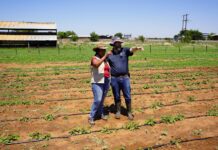By Nico Groenewald, Head of Agribusiness at Standard Bank
Agriculture showed its resilience and agility in a depressed economy and at the back of COVID-19 with strong growth and good trade results in 2020. The pandemic brought tough trading conditions both domestically and internationally due to lockdown restrictions. Despite these challenges, South Africa’s formal food supply chains remained resilient and functional.
In 2020, much of the agricultural sector saw bumper crops, and a reduction in wheat imports and citrus farmers enjoying a big increase in exports were good gains for the industry. The momentum is expected to continue in 2021.
At the aggregate level, the industry was able to record positive growth of 35%, 19.6% and 18.5% (quarter-on-quarter on a seasonally adjusted and annualised basis) during Q1-2020, Q2-2020 and Q3-2020, respectively.
Conversely South Africa’s GDP experienced a negative growth of 1.7% and 51.7%, in quarter one and two, respectively, before it experienced positive growth of 66.1% in the third quarter of 2020.
The record positive growth for three consecutive quarters is an indication that the sector is making a strong recovery from several difficult seasons of negative growth owing to droughts across the country.
The sector’s growth was driven by shared production growth in the three subsectors, namely, field crops, horticulture, and animal products and there is optimism about the industry’s performance in Q4-2020, with the Agriculture Business Chamber (Agbiz) estimating 10% growth and Bureau for Food and Agricultural Policy (BFAP) estimating 13% growth of the gross value added by the industry.
Agriculture’s performance can also be attributed to the fact that the sector was classified as essential and remained operational from the onset of the COVID-19-induced lockdown.
Initially, there were concerns about logistical challenges at the ports (domestic and receiving ports) and general uncertainty about global trade due to disruptions caused by the pandemic to global supply chains and the debilitating effect on the demand, but agricultural trade data shows that the sector has largely been insulated.
From the domestic side, this is mainly the result of joint efforts of both government and private sector to ensure that there was constant communication about challenges the industry faced, and action thereafter to resolve such glitches.
A bumper citrus harvest and expansion in deciduous fruit and vegetable production drove growth, which led to higher export volumes in Q3-2020 compared to Q3-2019. Avocadoes, nuts, berries, and grapes also recorded higher export volumes compared to volumes shipped in 2019. In terms of field crops, maize remains the largest industry and experienced the second largest bumper crop on record in the 2020/21 season, with volumes expected to reach 15.4 million tons.
Growth in wheat and oilseeds have also been experienced and going forward, we expect surplus field crop production to continue to support growth in the livestock subsector (the largest subsector by value), ensuring that the agricultural sector remains in the green in the final quarter of 2020.
The livestock subsector was able to perform well due to good demand for animal products.
The subsector benefited from higher prices spurred by improved demand following the wide reopening of local economic activities. Most meat prices have recovered to pre-lockdown levels due to improved demand in the market.
This is a welcome development as the livestock subsector did experience challenges of lower demand during various stages of the lockdown but adjusted well regardless of higher feed prices.
In the third quarter of 2020, South Africa saw record quarterly exports of US$3.2 billion which is an increase of 5% on a year-on-year basis. This occurred despite some challenges experienced due to border closures to curb the spread of coronavirus pandemic.
The growth in agricultural exports was primarily underpinned by citrus, wine, maize, nuts, deciduous fruit, and sugar cane. The bumper harvest across different fruit industries (including citrus, deciduous and subtropical), grains and livestock products enabled the country to record increased export throughout Q1 to Q3 in 2020.
Citrus dominated the export basket and export is expected to reach 2.5 million tons, representing an increase of 17% y/y. The African continent, Asia and the European Union were the largest markets for agricultural exports in the third quarter of the year, accounting for 30% and 29% in value terms, respectively. The balance of 12% by value was spread across the rest of the world, with the Americas being the dominant region.
During the early restrictions under the national lockdown the wine, tobacco and floriculture industries were amongst the hardest hit by the ban on sales during lockdown, but they are now steadily picking up. According to Wines of South Africa (WOSA), the wine industry is running at a R7.5 billion loss due to COVID-19, lockdown bans on sales and exports, and alcohol sales not being allowed over weekends.
The South African agricultural industry is expected to remain vibrant in 2021 owing to improvement in demand for fresh produce as consumers attempt to eat healthier and boost their immune systems to fight the virus.
South African farmers intend to increase area planted for summer grains and oilseed in 2020/21 production season by 5% to a total of 4.15 million hectares. The Agbiz/IDC Agribusiness Confidence Index (ACI) also supports a positive sentiment in the industry, recorded growth of 61 points in the Q4 of 2020, which is the highest level since Q3 of 2014.
According to the latest weather forecast report by the South African Weather Service (SAWS), Seasonal Climate Watch, there are increased chances of above-normal rainfall in the summer rainfall areas during the summer season. Some parts of the country have started to experience high rainfall. Climatic indications are set to be favourable in general and thus agriculture is likely to build on the current prospects.
The favourable weather conditions are expected to have a positive impact on the agricultural sector. Increased production and efficient farm practices will allow room for the industry to maintain its growth and continue responding to domestic and international demands of agricultural commodities. Domestic factors such as agricultural policies, infrastructure and irrigation, agricultural inputs amongst other factors also contribute to the growth of the sector.
Investments in agricultural technology remain key to sustaining growth in the sector. The ACI was above neutral point in the last quarter of 2020. This really shows that investors are optimistic about the future of agriculture and business conditions in the country.
The sector needs to attend to some challenges that it continues to experience including land reform, water reform, climate change, poor infrastructure, and access to market. Solving these challenges will be very important to keeping the industry competitive.
Agricultural exports play a growth-leading role in economic development, the increased demand of agricultural commodities in the global markets and the increased volumes exported contribute significantly to the economic growth of South Africa.
Agriculture can play an important role in contributing to economic growth, through increased agricultural production and job creation because of its linkages with the rest of the economy. Consequently, it can play a significant role in reducing poverty and provide food security in South Africa.









